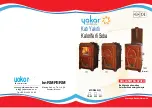
5.3 Suitable materials for lighting
The stove should be used for the combustion of natural wood and wood briquettes.
Some of the best wood for the stove is beech and birch. These types of wood have the
highest burn temperature, and they burn the cleanest, as long as they have been stored in
a dry place for a sufficient length of time.
If the glass window blackens excessively during burning it is usually an indication that the
moisture content of the firewood is too high.
Do not use any of the following:
•
Damp wood or treated wood
•
Cardboard
•
Bark or plywood
•
Plastic or other waste
Fresh wood should be cut up and stored for 12 to 18 months in open storage, but protected
from rain. Any wood used should have a maximum humidity of 20%.
5.4 Emptying the ashpan
It is recommended to clean out the ash every day. Keep a certain amount of ash on the
base of the firebox as it assists slow burning.
Be careful that too much ash is not accumulated otherwise there is the danger that, if the
ash reaches up to the grate, it will not cool sufficiently and may get damaged.
Before emptying the ashpan, check if there are any embers left in the ashtray.
Even though the ash is cold from the outside, it is possible that there are embers within the
ash which can lead to a fire in the waste bin.
5.5 Cleaning and maintenance
The chimney must be swept and the stove serviced at least once a year.
The stove can only be cleaned when it is cold.
Pay attention while cleaning your stove not to damage, scratch or break essential parts.
For cleaning steel parts use non-abrasive detergents and a soft rag, and after cleaning
wash it well to avoid the deposit of detergent which can damage material.
Cleaning the glass should be done when the stove is cold, using normal detergent for
washing the glass. In the case of solid deposits that need to be removed, we recommend
using a stove glass cleaner that is intended for that use. Alternatively a damp rag dipped in
a little bit of ash can be just as effective. After washing, wipe over with clean water.
10





































